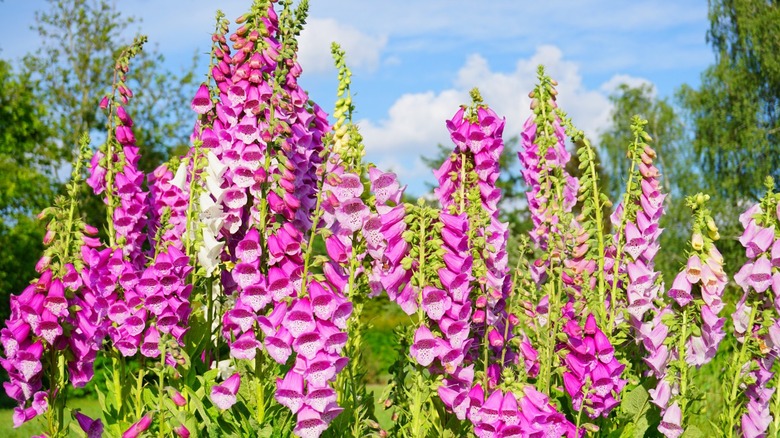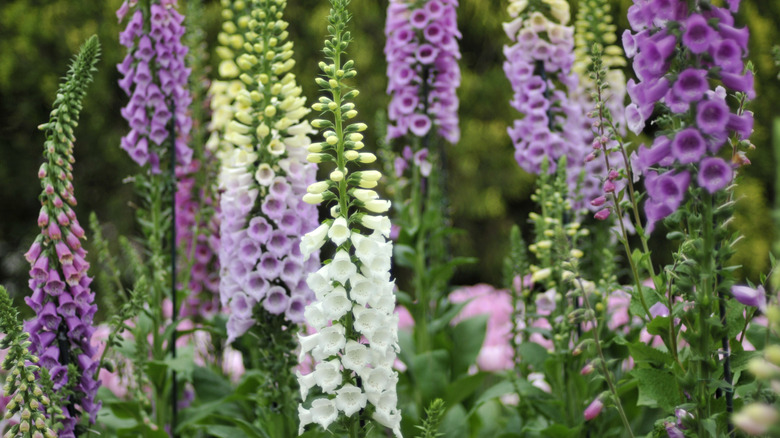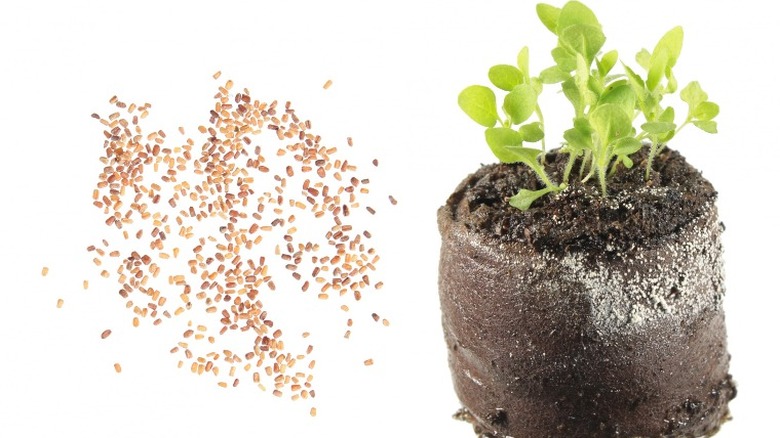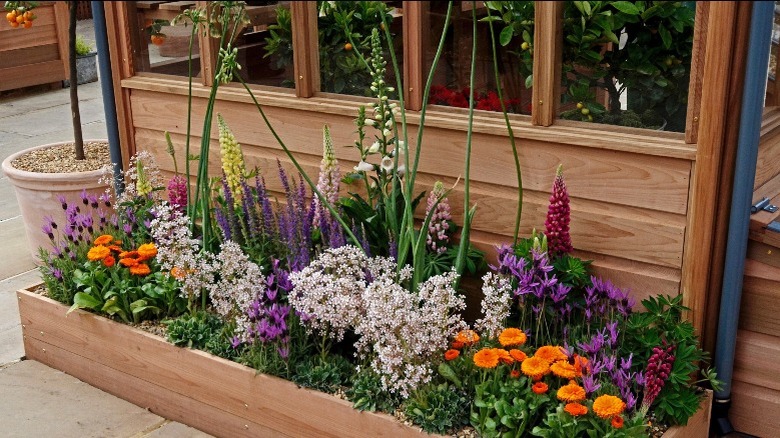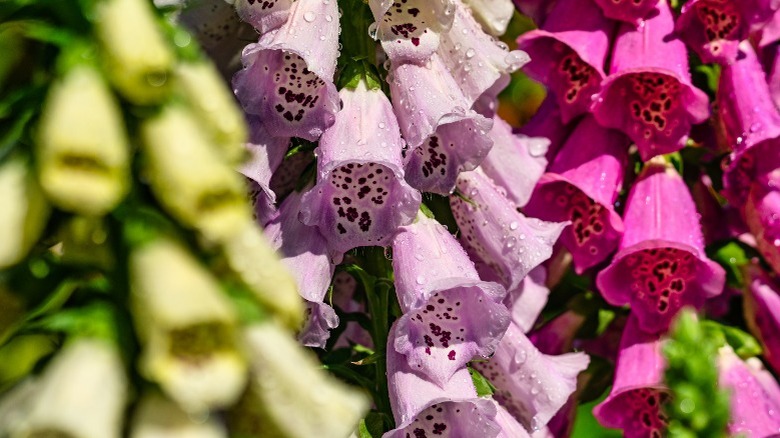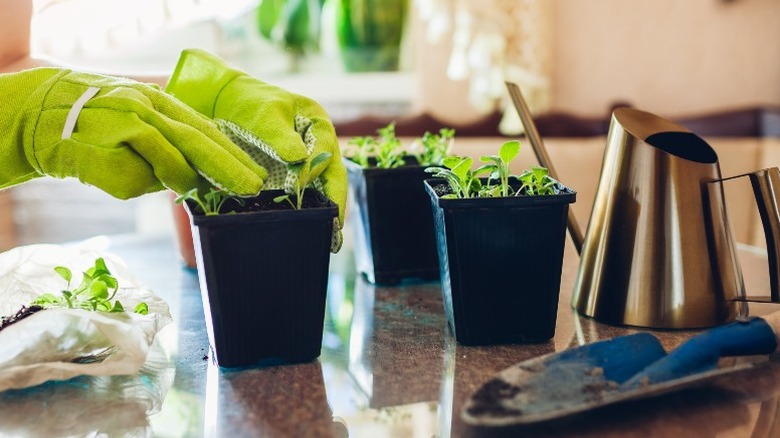How To Successfully Grow Foxgloves
Digitalis purpurea, or the common foxglove, is one of the most stunning and visually recognizable flowering plants and is commonly found in gardens in temperate climates. Its tall vertical blooms are covered in pastel pink and purple bell-shaped flowers, bringing drama, color, and height to gardens both large and small.
Gardeners' World describes foxgloves as trouble-free plants. While it's true that they are resilient, self-seeding, and require little intervention, that doesn't mean they are zero maintenance. You will need to keep an eye on them for up to two years, deadhead the blooms after flowering if you want to avoid reseeding, and, if growing one of the larger varieties, support the stalks so they stay upright throughout the summer.
However, it should be noted that if ingested, these beautiful flowers have a strong effect on humans and animals. Flower Magazine points out that although foxgloves have been used for a variety of ailments by medical professionals since the 1700s, even a slight overdose can completely stop a human heart. Therefore, it is better to leave the plant medicine to the experts and just enjoy these phenomenal flowering foxgloves for their aesthetic merits.
How to use foxgloves in garden
As with any plant primarily grown for its blooms, foxgloves bring several benefits to a garden. They provide color and texture to flowerbeds and borders and are well-loved by pollinators. Unlike many other flowering plants, the density and height that the foxglove can achieve, along with its color palette, opens up a lot of options for the mindful gardener. As recommended by Almanac, when planting foxgloves in a flowerbed, they are best kept towards the rear, leaving you room to plant other, shorter blooms in the fore.
The RHS estimates the final height of mature foxgloves to be between 3 and 5 feet tall. They aren't trees, but they are an excellent option for blocking out unsightly views or disguising walls and fences. They enjoy partial shade if grown in hot climates or full sunlight in chillier areas, as well as slightly acidic soil that's well-draining and rich in nutrients. Try to avoid planting them in overly dry or very wet conditions, as this can often result in no flowers or root rot, respectively.
The natural habitats of the foxglove are hedgerows and forest edges, according to Wild Food UK. Therefore, foxgloves and other members of the Digitalis family can be used to good effect as a border plant between wilder and tamer areas of the garden. This can help achieve both a colorful backdrop to neatly manicured lawns and seating areas and increased biomass in more natural areas.
How to grow foxgloves
Once you have decided to grow foxgloves, one thing you need to be aware of is the fact that they are biennials. As stated by The Sunday Gardener, this means that apart from a few specially bred varieties, foxgloves will only flower in their second year of growth. Another thing worth mentioning is that a single foxglove plant can produce up to a million seeds (per Plant Life). This means that growing abundant foxgloves requires adequate space, careful planning, and plenty of time.
If you don't mind spending the money, it's perfectly possible to buy year-old foxgloves from a nursery or garden center. Simply replant them in your garden once the last frost of the season has passed and wait for them to flower. After flowering, they will self-seed; however, any plants that germinate will again take two years to flower, so next year you might need to buy more foxgloves.
Alternatively, growing foxgloves from seed is relatively simple. Love the Garden has some tips for both indoor and outdoor sowing. Either way, sow the seeds on top of a well-balanced compost or a well-drained flower bed. Keep soil moist until germination occurs. Once the seedlings are large enough to handle, thin them out so each has enough space to grow — around 12 to 20 inches apart is sufficient. Then it's just a simple matter of waiting until next year's blooms arrive.
How to care for foxgloves
Foxgloves are fairly easy to keep happy as long as the soil they're in is well-draining, notes Gardening Know How, as waterlogged soils can quickly lead to crown rot. Other than making sure their conditions don't change too much throughout the year, almost all of the upkeep happens around the time that they blossom. This is because the two major tasks with foxgloves are stopping them from falling over when they have too many flowers and removing dead blooms and seed pods after they've finished flowering.
The ideal light conditions for foxgloves is full sunlight to partial shade; the hotter your summer, the more shade they'll need. They prefer moist, rich soil that's slightly acidic and well-draining. Martha Stewart explains that they are equally happy in containers or in the ground, as long as the soil and moisture conditions are met, and they will thrive with frequent, light watering, ideally at least 1 inch of moisture per week.
In terms of fertilizing foxgloves, this depends on the quality of your soil. If you're planting them into rich soil that's got a lot of organic matter, The Spruce observes that they won't need much assistance. However, if your soil is very poor, you can add a small amount of slow-release 5-10-5 fertilizer and water it in well. Avoid letting it touch the plant directly, though, as it may burn the leaves or stalk.
Foxglove varieties
The most common variety of foxglove is the Digitalis purpurea, yet there are many different varieties in existence today, as it is a popular flower notorious for self-seeding. Foxglove breeding happens for two reasons, either to create a new, pretty flower variation or as a way to hack the natural biennial rhythm of foxgloves and produce a perennial plant that blooms every year.
- Excelsior Hybrid: This is a stunning variety of the common foxglove that blooms in a wide range of colors from white through pink to lavender. According to Gardenia, this variety was awarded the coveted RHS Award of Garden Merit, and it is easy to see why.
- Dalmatian Purple and Foxy: These two semi-dwarf varieties take up less space than the common Digitalis purpurea. As per Gardener's Path, these varieties grow from 1.5 to 3 feet tall and are a good choice for growers with less space. Dalmatian purple has purple-flecked rose pink foliage, while Foxy ranges from white to deep purple.
- Digitalis x mertonensis: Also known as Strawberry, this hybrid is a mix of the common foxglove and the yellow foxglove, Digitalis grandiflora. According to Missouri Botanical Garden, its flowers are larger than either parent and it gains perennial status from the grandiflora side of the family.
- Digitalis lutea: This perennial can reach up to 23 inches in height and is characterized by pale yellow flowers that blossom in June and July.
Are foxgloves toxic?
All parts of the foxglove and any of the hybrids and other members of the Digitalis family are considered highly toxic. Therefore, it is vital to prevent pets and children from eating or otherwise ingesting them. According to Garden Doctor, it is even possible to experience poisoning or allergic reactions to foxgloves simply by skin contact, so whenever you are doing anything in the garden with them, be it repotting, staking, or removing them, it is important to wear gloves.
As Poison Control explains, compounds originally discovered in the foxglove plant are now widely used as heart medicine and sold under the name, Digitalis. However, anybody eating, making herbal tea, or otherwise ingesting Digitalis is, in effect, taking an unregulated amount of heart medication.
Additionally, HowStuffWorks notes that the concentration of toxins can vary widely but is generally at its highest just before the seeds drop. Digitalis poisoning has been known to slow a person's heart to a stop; conversely, it can also cause the heart to beat much faster. Because it cannot be accurately known in what concentrations the active ingredients are present, nor what a person or animal's reaction to the toxins might be, ingesting any amount of foxglove should be considered extremely dangerous.
How to repot foxgloves
When repotting your foxgloves, the first step is to prepare the space that they will be moved to, advises SFGate. Make sure the soil is rich, well-draining, and in a location with the correct level of sunlight. Loosen the top 12 to 15 inches of soil and dig in compost or fertilizer as needed.
Next, loosen the roots around the young foxglove with some water and either a garden fork or a trowel. The roots are usually relatively shallow, so dig around the plant, leaving space for the roots to spread, and lift it out. If it's already in a pot, just loosen the edges and gently lift it out. The hole you dig for your foxglove should be between two and three times the width of the root ball. This ensures that the soil is loose enough for the plant to push through easily as it establishes a larger root system. Avoid planting foxgloves too deep as this can cause root rot.
Place the plant into the prepared hole and backfill with soil — make sure it is loosely patted but not too compressed. Water well and keep the soil moist until you see signs of growth. According to Homes & Gardens, it's recommended to leave 12 to 15 inches between young foxgloves so they can spread their leaves adequately.
